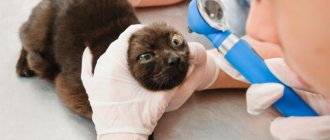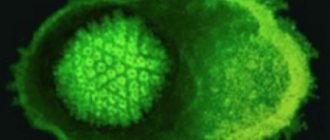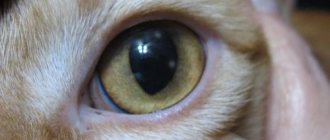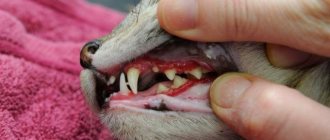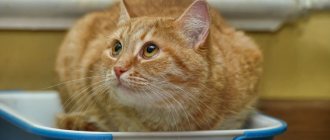The kitten's fragile immunity, restlessness and curiosity make the pet vulnerable to various infections and injuries.
Purulent discharge from the eyes is a common symptom not only of traumatic damage to the conjunctiva, but also of damage to the body by a viral, bacterial or other infection.
We will consider below what to do correctly when purulent discharge is detected.
Causes
Six main reasons for the formation of purulent discharge from the eyes of a kitten:
- allergic reaction to food, dust, pollen, medications, household chemicals, indoor plants, etc.;
- eye injuries;
- kitten diseases of a viral or bacterial nature, or helminthic disease;
- specks, foreign bodies in the eye (earth, sand, etc.);
- hypothermia of the kitten, for example, if the pet’s sleeping area is exposed to drafts;
- heredity, the breed's tendency to eye diseases.
About diseases
Infectious pathologies of various types interfere with the normal functioning of furry friends. When infected, the cat begins to sneeze, develops snot and even purulent discharge in the eye area.
© shutterstock
The list of abnormalities that cause a cat to get sick and sneeze may be different, for example:
- conjunctivitis;
- metabolic disease;
- external factors, for example, backcombing until it bleeds;
- injuries;
- inflammatory processes;
- and others.
You can't do this without a veterinarian. The pet sneezes, begins to worry, become nervous, the eyes become watery, and mucus starts to flow from the nose. There's definitely no time for joy here. But you cannot decide on your own how to treat a cat. You need to get to the root of the problem.
Species susceptibility
The breeds that are most often susceptible to purulent inflammation of the conjunctiva include:
- Scottish - due to the anatomical features of the muzzle (the lacrimal gland duct is shortened), frequent lacrimation causes the wool to get wet and become soaked, which creates a favorable environment for inflammation;
- British - facial features similar to the Scottish breed and a tendency to allergic reactions;
- Persian - a modified nasolacrimal duct due to the peculiar structure of the muzzle;
- Himalayan and Burmese - for them eye diseases are hereditary;
- Sphynx - low resistance to hypothermia and the absence of fur around the eyes, which performs a protective function.
Treatment of eye allergies
A characteristic feature of any allergic reaction is that in the absence of the allergen, the symptoms disappear without a trace. Accordingly, the ideal treatment method is the complete elimination of the allergenic factor from the patient’s living space, or the isolation of the patient from such factors (in some cases, the optimal solution is, for example, moving to another region or a dramatic separation from a furry pet).
Otherwise, both systemic and local antiallergic therapy is prescribed, which, like any other drug treatment, has significant drawbacks and pitfalls. For example, a number of drugs with this effect (especially previous pharmacological generations) negatively affect concentration and/or cause drowsiness; the effectiveness of treatment may decrease over time due to the addictive effect; with the accumulation of the active substance, in some cases the body may react to the components of the medicine itself as an allergen, etc. Therefore, any self-diagnosis and self-medication in this case are strictly contraindicated: antiallergic therapy is prescribed (based on the results of confirmatory diagnostics) and monitored only by a specialist in the appropriate field.
Antihistamines
The substance that is a mediator and regulator of immune allergic reactions in the body is called histamine. Accordingly, the action of the “antihistamines” known to many is based on the inhibition (suppression, suppression) of the specific activity of histamine-sensitive cells, or h1- and h2-receptors. Antihistamines for ophthalmic use come in a variety of forms, but are usually tablets or eye drops:
- Aktipol
- Allergodil
- Lecrolin
- Cromohexal
- Opatanol
- Spersallerg et al.
Hormonal agents in the treatment of allergies
Corticosteroid or non-steroidal drugs may be prescribed to relieve inflammatory symptoms and reduce swelling.
Corticosteroids are usually used in the form of eye drops, ointments or gels as adjunctive therapy, especially for chronic inflammation of allergic origin. The most common medications are hydrocortisone eye ointment, Dexamethasone and Prenacid eye drops. However, drugs in this group are considered unsafe and in no case should the patient be taken arbitrarily, on his own initiative: a side effect of uncontrolled use can be a persistent increase in IOP (intraocular pressure), excessive suppression of local immunity and other quite serious negative consequences.
NSAIDs (non-steroidal anti-inflammatory drugs)
Non-steroidal anti-inflammatory drugs are prescribed, as a rule, as part of combination therapy for severe seasonal catarrh, conjunctivitis, and uveitis. These include drops:
- Diclofenac
- Indocollier
- Diklof and Naklof
- Bronsiak
To eliminate swelling and hyperemia (redness) of the mucous membranes of the eyelids and skin of the eyelids, vasoconstrictor medications may be prescribed, but it should be understood that such drugs are not an etiopathogenetic treatment of allergies themselves.
If you have problems with your eye reaction to contact lenses, you should immediately stop wearing them until you consult with your supervising ophthalmologist. In any case, all rules and instructions for the safe and hygienic use, storage and care of lenses must be strictly followed.
Diagnostics in a veterinary clinic
The discharge of purulent exudate from a kitten’s eyes can be not only an eye disease, but also a signal of a dangerous infection in the pet’s body. A responsible owner's best bet is to visit a veterinarian immediately. The kitten’s immunity is very weak and without the provision of qualified medical assistance, the development of infection can destroy the pet.
When diagnosing, the following is carried out:
- examining a sick kitten for the presence of foreign bodies or traumatic eye injuries;
- finding out the reasons that irritate the mucous membrane of the eye;
- the nature and frequency of purulent discharge;
- microanalysis of washout from the mucous membrane of the eye;
- urine and stool analysis.
Depending on the condition of the animal and the nature of the illness, the doctor may prescribe:
- Ultrasound of the affected eye;
- X-ray of the skull;
- examination with an ophthalmoscope.
What are allergic eye diseases?
The symptoms of allergic reactions from the eyes are very diverse. This may be more or less mild redness, itching, blistering rashes, burning on the skin of the eyelids (allergic dermatitis), inflammation of the transparent mucous membrane (allergic conjunctivitis) with lacrimation, itching, etc. However, in some cases, the reaction is much more severe and leads to the rapid development of keratitis (toxic or infectious-allergic inflammation of the cornea), uveitis (allergic inflammation of the circulatory system of the eyeball), even to damage to the retina and optic nerve head.
The most common form of ocular allergic reaction, conjunctivitis, can take both an acute and chronic course. Symptoms are approximately the same in both cases: constant lacrimation, itching or pain in the eye, mucous exudate, characteristic glassy swelling of the conjunctiva (chemosis).
Hay fever, or seasonal hay fever, is a typical and widespread example of an allergic reaction, including an eye reaction, to pollen. In the classic version, the peak of hay fever occurs in August and is caused by one of the most powerful allergens, ragweed pollen - (ragweed belongs to the so-called “quarantine” weeds and must be purposefully destroyed by a special service, which, apparently, is not done everywhere and without special success). Hay fever can also be caused by poplar or dandelion fluff, grass, flowers and any other plants. Allergic conjunctivitis is almost never isolated and is usually accompanied by rhinitis (runny nose), uncontrollable repeated sneezing, rash and itching on the skin; Attacks of allergic bronchial asthma may also develop.
It is somewhat different from the so-called hay fever. spring catarrh is an allergic (kerato-) conjunctivitis, which is also a seasonal disease and develops with the arrival of the warm season. The reason has not been reliably established, but the hypothesis that spring catarrh is based on individually heightened sensitivity (hypersensitivity) to the ultraviolet part of the solar spectrum, which is generally dangerous for the eyes in many aspects, is quite well-reasoned. The role of allergenic pollen cannot be ruled out either. The features of such seasonal allergic inflammation are the incidence only in childhood (mainly in boys), the chronic type of course, the presence in the clinical picture of symptoms of photophobia, increased secretion of tear and mucous fluid; A specific manifestation is also the proliferation of papillary rashes on the inner conjunctiva of the eyelids (“cobblestone pavement”), less often along the limbus - the perimeter of the cornea.
Allergy to contact lenses is considered a special form of allergic reaction, which in most cases deprives patients with refractive errors of the opportunity to use this convenient method of optical correction. The direct allergen can be the lens material itself or the solution in which it is stored, but volatile allergens from the air can also settle on the surface of the lens (for example, when using aerosol hairsprays, insecticides, deodorants, etc.).
Treatment method and prognosis
The success of treatment depends on timely consultation with a doctor and a correct diagnosis.
In case of injury, depending on the damage, medications for pain syndrome, antibacterial, anti-inflammatory eye drops (ointments) may be prescribed, and in complicated cases (based on diagnostic results), antibiotics may be prescribed.
In case of blepharitis (inflammation of the eyelids), the doctor finds out the cause of the disease and prescribes the necessary treatment. In a kitten, the appearance of blepharitis may be associated with a lack of vitamins and poor diet.
If conjunctivitis is confirmed, the doctor prescribes comprehensive treatment. If you do not help your pet, the disease will eventually spread to the second eye and then to the nasopharynx.
In case of keratitis (inflammation of the cornea), the doctor determines the cause of suppuration of the organ of vision and prescribes a course of treatment.
In case of infectious lesions in the kitten’s body, the doctor prescribes general antibiotic therapy.
To preserve not only the vision, but also the life of the pet, it is very important to take the animal to the doctor when any pathology is detected: early diagnosis and effective therapy increase the chances of a favorable outcome of the treatment process.
Is this an allergy?
To establish an “allergic” diagnosis in ophthalmology, it is necessary, first of all, to carefully analyze the clinical picture and history, including hereditary predisposition, cases of allergies in blood relatives, similar reactions suffered by the patient in the past, allergens known to him and specific to him, dependence on the time of year, presence of pets in the apartment, etc. Laboratory blood tests are prescribed - in particular, the concentration of allergic markers - eosinophils, immunoglobulin E is studied. The most accurate way to identify an allergen, if it is unknown, is a series of intradermal injection allergy tests, however, even when testing the reaction to hundreds of potentially allergenic samples, there is no guarantee that it will be found the substance that is the dominant allergen for a given patient.
What to do at home
At home, it is necessary to strictly follow all doctor’s prescriptions, and ensure that medications are stored in accordance with the recommendations of the medical instructions.
To create conditions conducive to recovery, you need to provide your pet with a warm sleeping place in a quiet corner without drafts.
Nutrition is of great importance: the diet should be supplemented with vitamin supplements and ensure it is balanced.
Before carrying out the procedures, it is important for the owner to thoroughly wash their hands with soap and use separate wipes to clean each kitten’s eye of dirt. When used in the treatment or purification of solutions, the temperature of the liquids should not be lower than 37 degrees.
In the room where the kitten is located during treatment, the following are required:
- daily wet cleaning;
- replacing bedding on the animal's sleeping area;
- body temperature control;
- eye condition monitoring.
Possible diseases if a kitten sneezes
In addition to the above viral infections, possible diseases that cause sneezing in a kitten can be of a different nature. Unfortunately, the range of diseases is so wide that only a veterinarian can cope with the diagnosis.
The most dangerous are viral diseases, against which the kitten must be vaccinated.
If you pick up a baby on the street or buy it at a poultry market, the resulting viral diseases can cause its death.
Possible diseases of which sneezing may be a symptom are:
- Infectious peritonitis occurs without symptoms for a long time, and at an early stage of the clinical picture it is similar to a cold.
- Feline immunodeficiency virus is a slowly and secretly developing disease that adversely affects the body's immune system. When the cat's immunity level declines, it becomes vulnerable to any, even basic respiratory infections.
- Feline viral leukemia - in the first stages of development, is similar to a respiratory infection, in fact, it is a serious viral disease, which most often leads to death.
- Chlamydia - gives a complete picture of an acute viral respiratory infection complicated by bacterial infection. Unfortunately, chlamydia is highly contagious and common. One of the first symptoms of chlamydia is acute conjunctivitis.
- Mycoplasmosis is common, like chlamydia, contagious, and deadly. Mycoplasmosis progresses more slowly, but leads to more severe consequences: bacterial pneumonia and swelling of the respiratory tract.
Most viral infections cannot be diagnosed with guaranteed accuracy. To detect infection, blood is taken from the cat and examined for the presence of antibodies.
With viral infections, everything is a little more complicated; the causative agents of the disease must be found in the blood sample. This diagnostic method is called PCR. Unfortunately, PCR diagnostics are not available in all clinics and cost a lot of money, so most veterinarians, suspecting a viral infection in a kitten, begin complex, aggressive therapy.
Possible complications
If you refuse to visit the clinic and choose medications for your pet on your own, the disease takes on an advanced form and is dangerous due to its relapses. Fungal and parasitic skin lesions (mainly on the head) are possible, worsening the pet’s condition.
With an advanced form of infectious diseases and a kitten’s weak immunity, the pet will not be able to survive.
With eye disease and unqualified assistance, the damage affects the deep layers of the eye. In this case, the pet faces loss of vision.
How to put drops in a kitten's eyes
A small pet must be handled carefully, and before washing the kitten’s festering eyes, you need to figure out how to hold the animal so as not to injure or frighten it.
Place your baby on his back with his face pointing up. If the kitten's eyes do not open, soak the eyelids with chamomile infusion or boiled water. After this, remove the pus and only then instill the medicine.
On average, therapy lasts about a week, but much depends on the degree of neglect of the disease and its nature.
Remember, self-medication should be used only in one-time cases of purulent discharge. If ichor is constantly secreted, abundantly, and there are other symptoms of a dangerous pathology, use the services of a specialist. As an example, with conjunctivitis, a kitten should be examined for chlamydia. Another examination is needed to find out how tolerant the pet is to antibiotics.
Among other things, the veterinarian knows exactly what treatment to prescribe in each individual case, which greatly increases the chances of successfully resolving the situation and, as a result, the kitten maintains full vision and health.
Prevention
A cold is not dangerous for an animal with normal immunity, but the disease causes discomfort to the cat and is quite difficult to treat. It is much easier to prevent infection. The following measures help with this:
- Proper care of animals. For the first few weeks of life, kittens should be kept in a warm, draft-free room. Trays and sleeping places for adult animals should also not be in rooms with cold air.
- Gradual adaptation to the street. You need to start this procedure in the warm season. The cat is allowed outside for several hours. In this case, you need to ensure that the animal does not become hypothermic. In rainy and windy weather, walks are avoided.
- Proper bathing. The cat needs to be bathed with warm water. After the procedure, the fur is thoroughly dried with a towel, while the pet should be in a warm room.
- Proper nutrition. The diet should include balanced food and sufficient fluids. Do not give your cat cold food or water.
Under what conditions can tonsils be enlarged without fever?
Without an increase in temperature, the tonsils can become inflamed due to:
- Allergies. Enlarged tonsils often occur in people prone to allergies. Allergens include various substances - animal hair, dust, pollen, food, insects, household chemicals.
- Fungal infection. The following symptoms are observed: sore throat, dry mouth, visible cheesy coating on the mucous membrane.
- Dry air. Due to constant inhalation of dry air, the mucous membrane of the larynx dries out, causing the tonsils to swell. Working in polluted conditions also leads to this.
- Smoking. Tobacco smoke burns the mucous membrane, which can result in swelling of the tonsils.
- Some forms of sore throat (tonsillitis). The biological meaning of an increase in temperature during infectious diseases is to accelerate the death of pathogenic carriers in an environment with high temperatures. Consequently, if the body temperature has not increased, it means that the number of infectious carriers that have entered the body is small. Usually, if the infection was minor, then the person easily and quickly suffers from this illness. But with enlarged tonsils and no temperature, we can talk about an untreated acute inflammatory process in the tissues of the tonsils and its transition to chronic. In this case, the recovery process will take longer, and in addition, there is a possibility of complications developing. Both variants of pathologies require examination and prescription of correct treatment by an otolaryngologist.
Features of the condition with enlarged tonsils without fever
Even at normal body temperature, but in the presence of pathological processes in the body, a person may feel completely unwell. Inflammation of the tonsils without fever, regardless of the cause, can interfere with a normal lifestyle and be accompanied by:
- headache;
- sore throat;
- lack of appetite;
- difficulty swallowing;
- dryness and sore throat;
- enlarged lymph nodes and pain on palpation;
- fatigue, weakness, drowsiness, decreased performance, irritability.
Dangerous causes requiring special attention
- Viral, infectious and fungal diseases . Leukemia, immunodeficiency, rhinotracheitis, calicivirus and other dangerous diseases include sneezing in the list of symptoms. These diseases are fatal without timely diagnosis and treatment. At risk are kittens, pregnant and elderly animals, as well as animals picked up from the street or taken from shelters. It is important to understand that vaccination also does not provide 100% protection against infection and these diseases cannot be ruled out even in vaccinated pets!
- Tumors and polyps . If you notice that your pet has constant nasal congestion, sneezing and a runny nose, then one of the reasons may be a new growth in the nasal passage. To diagnose such a problem, you need to go to the clinic for an examination. Most likely, a rhinoscopy (using an endoscope) will be required to remove this tumor.
- Asthma . If, in addition to sneezing, your pet experiences wheezing, shortness of breath, or coughing, this may be a manifestation of asthma. In this case, you should contact the clinic for a more accurate diagnosis and prescription of medications.
- Dental problems . Often sneezing occurs due to dental problems. At the same time, the pet rubs its mouth and nose with its paws, and it often has difficulty eating. Examine your cat's oral cavity: if you notice plaque on the teeth, redness of the gums, an unpleasant odor, or drooling, you should consult a dentist.
- Worms . Infection can manifest itself in different ways, including a runny nose with wheezing. If you notice abnormal bowel movements, weight loss, dull hair, or a rounded belly, you need to get tested and treat parasites with medications recommended by your doctor.
In these cases, it is dangerous to self-medicate a runny nose; you need to go to the clinic as soon as possible.
You need to go to the vet urgently if:
- the cat sniffles, breathes with its mouth open;
- in addition to mucus, blood or pus is discharged from the nose;
- there is an increase in temperature - the pet has a hot nose and paw pads;
- there is redness of the eyes, lacrimation, and formation of pus;
- lethargy, anxiety, refusal of food and water, weight loss are manifested.
Symptoms
The disease is manifested by several symptoms: itching of the mucous membranes, sneezing, watery nasal discharge (rhinorrhea), and nasal congestion, and sometimes even conjunctivitis. With obstruction (obstruction syndrome of the human respiratory system), headaches often occur. Allergic rhinitis can lead to complications such as sinusitis.
The causes of rhinitis can be pollen, mold spores, wool, fluff and waste products of animals (cats, dogs, rodents), dust mites, cockroaches.
Asthma is a frequent accompaniment of allergic rhinitis, but it is not yet clear whether a false runny nose is the cause of asthma or whether both of these diseases are based on the same cause - the allergic process. With asthma accompanying hay fever, the patient may experience shortness of breath and a severe cough.
Treatment of enlarged tonsils without fever
Before prescribing treatment, it is necessary to establish the cause of inflammation of the tonsils.
If the cause is an infectious or fungal infection, then the patient is prescribed a course of antibacterial therapy, treatment of the throat and mucous membranes with special preparations, infusions into the larynx, rinsing the tonsils, and taking vitamin complexes to support the immune system.
If conservative treatment is ineffective, a tonsillectomy may be prescribed - surgical removal of the tonsils. Most often, this is an indication for the treatment of chronic tonsillitis, which occurs with toxic-allergic manifestations and seriously interferes with a person’s comfortable life.
If swelling of the tonsils is associated with external factors - smoking, working in unsuitable conditions, attacks by allergens, the doctor will advise correction of lifestyle or environmental conditions, and taking supportive medications.

